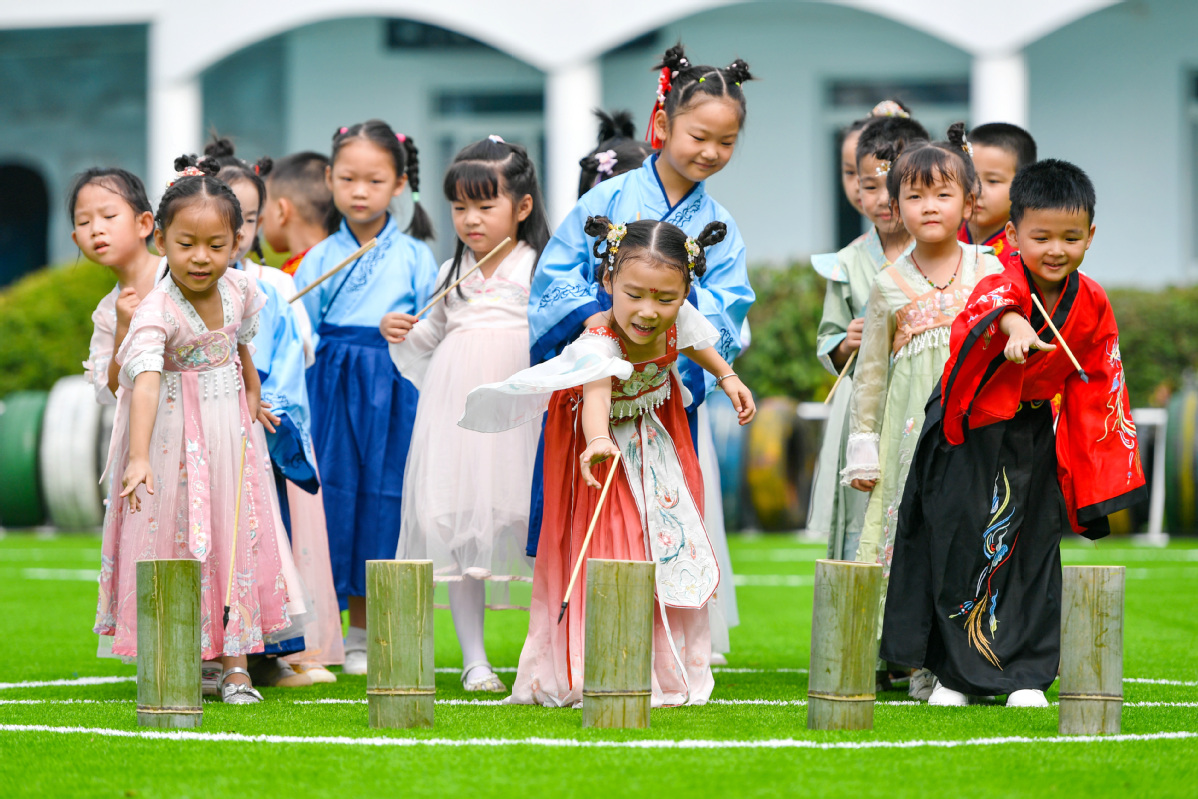Nation to Continue Promoting Protecting Heritage, Traditions

Children play a game of Touhu in which contestants throw arrows into wine pitchers at a kindergarten in Changxing county, Huzhou city, Zhejiang province, on Sept 8, 2022. [Photo by Tan Yunfeng/chinadaily.com.cn]
China will continue to stress efforts to inherit and enhance the influence of traditional culture.
According to a report delivered by Xi Jinping, general secretary of the Communist Party of China Central Committee, at the opening session of the CPC's 20th National Congress on Oct 16, China will put more efforts into the protection of cultural relics and cultural heritage, and into strengthening the protection and inheritance of history and culture in urban and rural construction.
The report affirmed the significant achievements of cultural undertakings in the past decade. It said China will promote cultural confidence and strength and further glorify socialist culture.
Deng Chao, an official at the National Cultural Heritage Administration, said the nation should implement the cultural heritage work policy, which is to prioritize cultural protection, strengthen management, explore its value and make effective use of relics.
"We need to increase the comprehensive, systematic and overall protection of cultural relics and cultural heritage, and promote cultural heritage protection," Deng said.
Li Liusan, head of the China Academy of Cultural Heritage, said the academy will focus on the goals and responsibility as the "national team" for cultural relics protection.
They will also strengthen top-level design and overall planning, and deepen institutional and mechanism reforms, as well as strengthen theoretical research on cultural relics protection and excavate and explain the value of cultural relics, Li said.
"We will also accelerate the construction of a national science and technology innovation center for cultural heritage," he said.
Cao Jian'en, director of the Cultural Heritage Administration of the Inner Mongolia autonomous region, said that based on the endowment and advantages of the region's cultural heritage resources, the administration will ensure that the policies issued by the National Cultural Heritage Administration as part of the 14th Five-Year Plan (2021-25) will be implemented.
He said his department will also enhance the protection and management level of immovable cultural relics, as well as build and make use of national culture parks, including those related to the Great Wall and the Yellow River.
"We will continuously improve the legal and regulatory system for cultural relics and promote the process of legalizing protection of cultural relics," he said.
Over the past decade, a series of policies have been launched — from guidelines promoting the reform and development of museums to the implementation of archaeological work outlined in the 14th Five-Year Plan, as well as the overall plan for Great Wall protection — that have provided specific guidance on cultural heritage work.
Since 2013, the National Cultural Heritage Administration, together with over 20 related organizations, has issued more than 80 policy documents involving the management of cultural heritage resources, cultural heritage security, archaeological management, revolutionary cultural relics, museum reform and development, and other related matters.
A policy on "strengthening the management of private collections of cultural relics and promoting the orderly development of the heritage market" was jointly issued by six organizations in December last year.
Local governments also continue to pay more attention to cultural heritage work by issuing relative policies and guidelines. Thirty-one provincial-level regions have launched policies targeting reform of cultural relics protection and have incorporated cultural heritage safety into their local government assessment systems.
Meanwhile, 18 have included the protection of cultural relics in the scope of public interest litigation.
According to the National Cultural Heritage Administration, over the past 10 years it has insisted on prioritizing cultural relics safety and continuously improving their inspection mechanisms for cultural relics. With the deepening of cooperation between their cultural relic security departments, the situation continues to improve.
The administration has handled over 5,000 cases involving the illegal possession of cultural relics, and directed public security offices to investigate 10,000 relic-related crimes, recovering 150,000 items in the process.
It has also cooperated with fire departments to look into and rectify over 200,000 hidden hazards at cultural relic sites.
